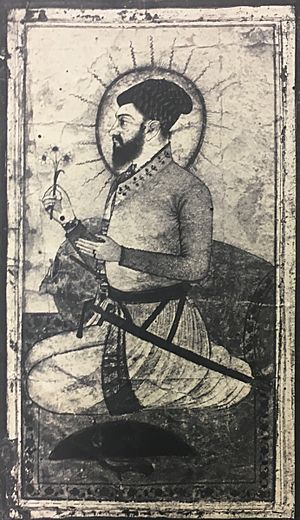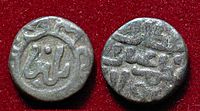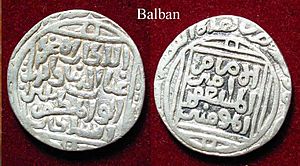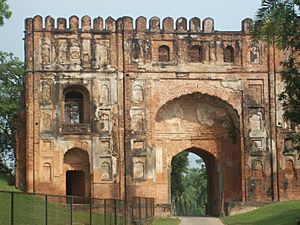Ghiyas ud din Balban facts for kids
Quick facts for kids Ghiyas ud din Balban |
|
|---|---|
| Sultan | |
 |
|
| 9th Sultan of Delhi | |
| Reign | 1266–1286 |
| Predecessor | Nasiruddin Mahmud |
| Successor | Muiz ud din Qaiqabad (grandson) |
| Born | 1216 Delhi |
| Died | 1287 (aged of 71) |
| Burial | Tomb of Balban, Mehrauli Archaeological Park, Delhi |
| Issue |
|
| House | House of Mamluk |
| Religion | Sunni Islam |
Ghiyas ud din Balban (born 1216, died 1287) was an important ruler of the Mamluk dynasty in Delhi. He ruled as Sultan from 1266 to 1287.
Before becoming Sultan, Ghiyas ud Din was a powerful regent for the previous Sultan, Nasiruddin Mahmud. A regent is someone who rules for a king or queen who is too young or unable to rule. Balban removed his rivals in the court to gain more power.
His original name was Baha Ud Din. He was from a Turkic group called Ilbari. When he was young, Mongol invaders captured him. They took him to Ghazni and sold him as a slave. Later, a Sufi scholar named Khawaja Jamal ud-din of Basra bought him. In 1232, Khawaja brought Balban and other slaves to Delhi. There, Sultan Shams-ud-din Iltutmish bought them.
Balban was part of a famous group of 40 Turkic slaves who were very close to Sultan Iltutmish. This group was known as the 'Corps of Forty'.
Balban led several successful military campaigns, even before he became Sultan. He defeated the Mewatis, who were causing trouble near Delhi. He also took back control of Bengal. Balban successfully defended his lands against the powerful Mongols, though his son died in one of these battles. After Balban's death in 1287, his grandson Qaiqabad became Sultan. However, Qaiqabad's rule was not as strong as Balban's.
Even with few major military wins, Balban made big changes to how the government and army worked. These changes led to a stable and rich kingdom. Because of his strong rule, Balban is seen as one of the most powerful rulers of the Delhi Sultanate, alongside Shams-ud-din Iltutmish and Alauddin Khalji.
Contents
Early Life and Rise to Power
Balban was born into a noble Turkic family in Central Asia. When he was a child, Mongols captured him and sold him as a slave. A scholar named Khwaja Jamal ud-din Basri bought him. Khwaja then brought Balban to Delhi. In 1232, Sultan Shams-ud-din Iltutmish bought Balban and other slaves. Iltutmish himself had been a captured Turk.
Balban started as a simple water carrier. But he quickly rose through the ranks. He became the Sultan's personal attendant, called a Khasdar. He was one of the most important members of the 'Chalissa', a group of forty powerful Turkic nobles in Delhi.
During the rule of Razia Sultan, Balban held an important position called amir-i-shikar, or lord of the hunt. This job had both military and political duties. After Razia Sultan was overthrown, Balban gained more power. He received land in Rewari and later became the lord of Hansi, which was a very important area.
Balban played a key role in removing Sultan Ala ud din Masud. He then helped Nasiruddin Mahmud become Sultan in 1246. Balban served as Mahmud's chief minister, or Vizier, from 1246 to 1265. Sultan Mahmud even married one of Balban's daughters. Balban also made his younger brother, Kishlu Khan, the lord chamberlain. His cousin, Sher Khan, became the lord of Lahore and Bhatinda.
Balban's growing power made some other nobles jealous. His main opponent was Imad ud-din Raihan. Imad ud-din convinced the Sultan that Balban was trying to take over. Balban and his family were removed from their positions. However, Balban managed to negotiate with the Sultan. Imad ud-din was dismissed in 1254, and Balban got his position back.
Military Achievements

Balban believed that a strong government needed people to respect its power. He also said that the Sultan was like "God's shadow" on Earth. He made strict rules for his court. Balban relied on Turkic nobles but built a large army of 2 lakh (200,000) soldiers from different groups. Some of his army were special commando units. As Vizier, Balban had several military successes. In 1246, he helped stop a Mongol attack on Uch.
In 1275, the governor of Bengal, Tughral Tughan Khan, declared himself independent from Delhi. Balban sent two armies to stop him, but both failed. So, Balban led a third army himself. He took back control of the area and killed Tughral and his followers. His son, Nasiruddin Bughra Khan, helped him. Balban then made his son, Bughra Khan, the new governor of Bengal. However, after Balban's death, Bughra Khan declared Bengal independent again and kept it that way for 40 years.
One of Balban's famous campaigns was against the Meo people of Mewat. They often attacked people in Delhi, even during the day. The historian Ziauddin Barani described how much trouble the Mewatis caused. They would come into the city at night, robbing people. They also plundered country houses nearby. The roads were dangerous, and merchants could not travel safely. The Mewatis were so bold that the western gates of Delhi were closed in the afternoon. No one dared to leave the city after that time. They even attacked water carriers near the Sar-hauz, stealing their clothes.
Balban decided to stop the Mewatis. He destroyed their strongholds and villages. He built military outposts and gave land to soldiers and Afghans to settle there. He also put soldiers in forts at important places. He cleared forests and made sure the roads were safe. He tried to capture Ranthambore but failed. However, he did take back Gwalior from the Rajputs.
In 1247, Balban also put down a rebellion by the Chandela Chief of Kalinjar.
Balban's rule was also known for successfully fighting off the Mongol army. His cavalry horses were better suited for the Indian climate and were larger than Mongol horses. The extreme heat of Indian summers also made it hard for the Mongols to stay long. Their attacks were usually short, even when they were not defeated by Delhi's forces. They mostly happened in winter when it was cooler for their horses.
Balban's Reign as Sultan
Sultan Nasiruddin had no sons. So, after his death, Balban declared himself the Sultan of Delhi. Balban became Sultan in 1266, at the age of sixty. He took the title Sultan Ghiyas-ud-din-Balban.
During his rule, Balban was a very strict leader. He broke up the 'Chahalgani', the group of forty most powerful nobles. Balban wanted to make sure everyone was loyal to him. He set up a very good spy system, like the Umayyads had. He had spies, called barids, who reported on his officials. He placed secret reporters in every government department. These spies reported only to the Sultan.
Balban punished his nobles very harshly for any mistakes, even for treating their own slaves badly. One governor, Haibat Khan, was given to a slave's widow for punishment. Historian Dr. Ishwari Prasad said that people were so afraid of Balban's strict justice that no one dared to mistreat their servants or slaves.
Balban also reorganized the army to better fight the Mongol threat. He changed how land grants (called Iqtas) were managed. These lands were given to soldiers in return for their service. Many had passed down to children or were kept even if the original holder no longer served. Balban wanted to make sure that only active soldiers received these lands. Old commanders who could no longer serve were given a pension. Younger commanders were taxed on extra income from their lands. Women and children who inherited Iqtas were to lose them but receive money to live on. However, an old official convinced him to let some old nobles keep their lands.
Balban's actions against the nobles were very strict. It is even said that he poisoned his own brother, Sher Khan, because of their disagreements.
Balban's court was very serious. There was no laughter or fun, and wine and gambling were forbidden. He made strict rules like prostrating (bowing down) before the king and kissing his feet. However, Balban still went on hunting trips. These trips were often used as military training. During his rule, many people in Punjab converted to Islam. Balban was also the first to introduce the Persian festival of Nowruz (meaning New Year) in India.
He introduced the Persian customs of Sijda (prostration) and Paibos (kissing the feet) to the Sultan in India. He also called himself Niyabat-i-Khudai, meaning "Deputy of God."
Death and Legacy
Ghiyas ud din Balban ruled as Sultan from 1265 until his death in 1287. Balban's chosen heir was his older son, Prince Muhammad Khan. But Prince Muhammad died in a battle against the Mongols in 1285. His other son, Bughra Khan, did not want to be Sultan. He preferred to remain the ruler of Bengal. So, Balban chose his grandson, Kaikhasrau, Prince Muhammad's son, as his heir. However, after Balban's death, his nobles chose Qaiqubad as the new Sultan instead.
Qaiqubad ruled from 1287 to 1290. His father, Bughra Khan, declared Bengal independent. Qaiqubad was a weak ruler. He eventually suffered a stroke and had to pass the rule to his three-year-old son, Shamsuddin Kayumars. But Kayumars was soon removed by his guardian, Jalal ud din Firuz Khalji in 1290. This event brought an end to the Mamluk (Slave) dynasty.
Today, Balban's tomb is located in the Mehrauli Archaeological Park in Delhi. Next to it is the tomb of his son, Khan Shahid, and a mosque. The domes of both tombs had fallen, and the buildings were mostly ruined. But they have been restored in recent years as part of conservation efforts in the park.




